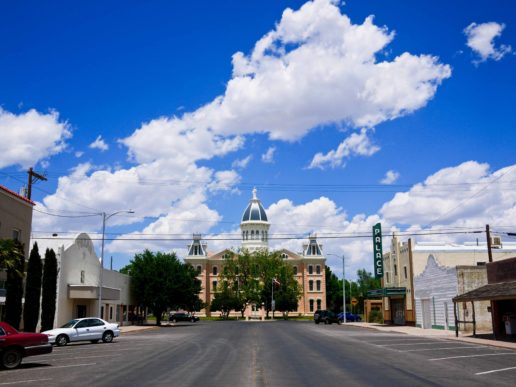A Touch of Brooklyn in West Texas by Arthur Mallett
May 13, 2016 arthur mallet,brooklyn,dan flavin,dia art foundation,donal judd,john chamberlain,marfa lights,marfa texas,marfa TX,prada marfa

Recently, some friends and I took a trip to Marfa, TX. Located in the southwestern part of the state, near the Mexican border, Marfa is hours from any major city, surrounded by miles of desert with jutting plateaus. It is a vast lunar landscape where a strange phenomenon of a phantom glow has been called the “Marfa Lights” (we had no luck seeing this). The town was founded as a water stop for trains and grew around an army base in the early twentieth century. It served as the backdrop for some major western films in the 1950’s including Giant and High Lonesome.
It wasn’t until minimalist artist Donald Judd arrived in the 1970’s, however, that Marfa began to foster a reputation as a destination for creativity. Aided by the Dia Art Foundation, Judd bought up a number of properties in the area, including a former army base. That property became the headquarters of the Chinati Foundation where Judd’s iconic 15 works in concrete as well as 100 works in Mill Aluminum. Other artist’s whose work is on display include John Chamberlain and Dan Flavin. Judd believed art should remain in it’s place permanently. Although he died in 1994, most of his properties in Marfa, including his residence have remained unaltered.
In the wake of all of the artistic activity, Marfa has gradually become a more accommodating destination in other ways. With a steady stream of visitors, there are a variety of quirky hotels, RV parks and AirBnB’s like the Adobe loft where we stayed. There are high end boutiques like the Cobra Rock Boot Company and Communitie, a hat and clothing store where you are liable to end up on Instagram if you try anything on. There are lunch spots like the “Boyz 2 Men” taco truck open on weekends, where they have mastered the art of making ordering as confusing as possible. Change is given in Susan B. Anthony coins and two-dollar bills and they will try to push you to buy a souvenir mug with their slogan “Most People Get Four.” There are craft cocktail bars and a great dive bar called the Lost Horse Saloon. For after-hours snacking, many people flock to the “Museum of Electronic Wonders & Late Night Grilled Cheese Parlour”, which is exactly as advertised.
I’m not the first to point out the likeness between modern Marfa and modern Brooklyn. That I was able to easily acquire a jar of McClure’s pickles and a kombucha at the Stop and Go was both comforting and unsettling. There is a recognizable common ground that can be seen in the clothes people wear, the fonts on the store signs and the products available. It is an aesthetic that has been picked up by the media in the last few years and made it’s impression on the country at large. Brooklyn is the undisputed kingdom of this phenomenon, but clearly there are far-flung pockets to be found. There was a feeling of being very close to home while being many miles away.
In three-and-a-half days, we had covered many, but not all of the attractions of this little town. We had run into the same people everywhere we went and began to assume a false sense of seniority over the newcomers. We headed west, back into the desert towards El Paso. After about 30 miles of open road we came upon the last stop on the tour: Prada Marfa. Constructed in 2005, it permanently house that year’s Fall collection. It has no entrance, just the large glass window displays you would find on Fifth Avenue. Once again that strange feeling of familiarity and remoteness set in. We continued on to the El Paso airport and a few hours later I was back in Brooklyn, like I had never left.












